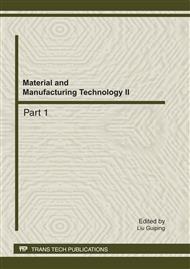[1]
S. Thamizhmanii, S. Saparudin, S. Hasan: Analyses of Surface Roughness by Turning Process Using Taguchi Method, Journal of Achievements in Materials and Manufacturing Engineering, 20, (2007).
Google Scholar
[2]
K. R. Jamaludin, et al.: Injection Molding Parameter Optimization Using the Taguchi Method for Highest Green Strength for Bimodal Powder Mixture With SS316L IN PEG and PMMA, in: World Congress on Powder Metallurgy & Particulate Materials, Washington D. C., 8-12 June (2008).
Google Scholar
[3]
F. O'Dowd, M.D. Gilchrist: Optimizing Molding Conditions to Improve the Quality of Injection-Molded Parts: A Design of Experiments Approach, SME Plastics Insights, vol. 3, No. 4, pp.1-9, (2004).
Google Scholar
[4]
H. Oktem, et al. : A Study of the Taguchi Optimization Method for Surface Roughness in Finish Milling of Mold Surfaces, Int J Manuf Technol, vol. 28, pp.694-700, (2006).
DOI: 10.1007/s00170-004-2435-6
Google Scholar
[5]
R. S. Chen, H. H. Lee, C. Y. Yu: Application of Taguchi's Method on the Optimal Process Design of an Injection Molded PC/PBT Automobile Bumper, Composite Structures Vol. 39, Nos 3-4, pp.209-214, (1997).
DOI: 10.1016/s0263-8223(97)00110-4
Google Scholar
[6]
T. C. Chang, et al. : Optimization of Weld Line Quality in Injection Molding Using an Experimental Design Approach, Journal of Injection Molding Technology, vol. 3, (1999).
Google Scholar
[7]
J. Lamminmäki, T. Lindgren, J. Silén, H. Vesanto: Influence of Injection Molding Process Parameters on Mechanical Properties of Polypropylene-Specimen, Baltic Polymer Symposium, Tallinna, Estonia, (2001).
Google Scholar
[8]
S. Kamaruddin, Z. A. Khan, K. S. Wan: The Use of the Taguchi Method in Determining the Optimum Plastic Injection Moulding Parameters for the Production of a Consumer Product, Jurnal Mekanikal, vol. 18, pp.98-110, (2004).
Google Scholar
[9]
R. Surace, et al.: Application of Taguchi Method for the Multi-Objective Optimization of Aluminium Foam Manufacturing Parameters, Int J Mater Form, vol. 3, p.1–5, (2010).
DOI: 10.1007/s12289-009-0409-9
Google Scholar
[10]
J. Zhu, J. C. Chen, D. Kirby: Tensile Strength and Optimization of Injection Molding Processing Parameters Using the Taguchi Method, International Journal of Modern Engineering, Vol 4, No. 2, pp.1-6, (2005).
Google Scholar
[11]
N. Rao and K. O'Brien: Design Data for Plastics Engineers, Hanser / Gardner Publications, Inc., Cincinnati, 208 pages, (1998).
Google Scholar
[12]
R. K. Roy: A Premier on Taguchi Method, Van Nostrand Reinhold, New York, (1996).
Google Scholar
[13]
Information about Polyamide-6 (Nylon-6) on http: /www. matweb. com.
Google Scholar


